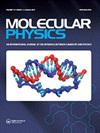空位缺陷和掺杂过渡金属的磷烯-石墨烯异质结构对h2 - S吸附的第一性原理研究
IF 1.6
4区 化学
Q4 CHEMISTRY, PHYSICAL
引用次数: 0
摘要
摘要利用密度泛函理论计算了H2S在原始、缺位和掺杂过渡金属(TM)的磷烯-石墨烯(PG)异质结构上的吸附稳定性、几何特性、电子和磁性能。在原始和有空位缺陷的PG体系中,H2S与异质结构的相互作用较弱,作用机制为物理吸附。tm掺杂(Ti, V, Cr, Mn, Co, Ni)后,掺杂剂与H2S之间的强轨道杂化显著增强了H2S与掺杂异质结构之间的相互作用,H2S的物理吸附机制转变为化学吸附。H2S分子在mn掺杂的PG异质结构上的吸附能和解吸时间适宜,可作为检测H2S气体的传感器。掺杂Cr和mn的PG异质结构的态密度表现为不对称的电子自旋态,表明存在磁矩。因此,在PG异质结构上引入缺陷和TM掺杂剂可以提高H2S的灵敏度,为开发气体检测传感器提供理论基础。关键词:磷烯-石墨烯异质结构传感器dft过渡金属掺杂物披露声明作者未报告潜在利益冲突。基金资助:国家自然科学基金(no . 61874160和11604080),河南省高等学校重点科学基金(no . 22A140005),河南省自然科学基金(no . 202300410125),河南大学科技创新团队计划(no . 22IRTSTHN012),河南大学物理与工程学院学生科研训练计划(no . WLSRTP202201)。本文章由计算机程序翻译,如有差异,请以英文原文为准。
First principles studies of adsorption of H 2 S on vacancy defected and transition metal-doped phosphorene-graphene heterostructures
AbstractThe adsorption stability, geometry, and electronic and magnetic properties of H2S adsorbed on pristine, vacancy defected, and transition metal (TM)-doped phosphorene-graphene (PG) heterostructures were calculated using density functional theory. In pristine and vacancy defected PG systems, the interaction between H2S and the heterostructure was weak, and the mechanism was physical adsorption. After TM-doping (Ti, V, Cr, Mn, Co, and Ni), the strong orbital hybridisation between the dopant and H2S significantly enhanced the interaction between H2S and the doped heterostructures, and the physisorption mechanism of H2S changed to chemical adsorption. The adsorption energy and desorption time of H2S molecules on Mn-doped PG heterostructures was suitable, which can be applied as sensors to detect H2S gas. The density of states of Cr- and Mn-doped PG heterostructures exhibited asymmetric electron spin states, indicating the existence of magnetic moments. Thus, introducing defects and TM dopants on PG heterostructures can improve H2S sensitivity, providing a theoretical basis for developing gas detection sensors.KEYWORDS: Phosphorene-graphene heterostructuresensorDFTtransition-metal dopant Disclosure statementNo potential conflict of interest was reported by the author(s).Additional informationFundingThis work is supported by National Natural Science Foundation of China (NSFC, Grant Nos. 61874160 and 11604080), Key Science Foundation of Higher Education of Henan (22A140005), Natural Science Foundation of Henan (grant number 202300410125), Program for Innovative Research Team (in Science and Technology) in University of Henan Province (22IRTSTHN012), and the Student Research Training Program of School of Physics and Engineering (grant number WLSRTP202201).
求助全文
通过发布文献求助,成功后即可免费获取论文全文。
去求助
来源期刊

Molecular Physics
物理-物理:原子、分子和化学物理
CiteScore
3.60
自引率
5.90%
发文量
269
审稿时长
2 months
期刊介绍:
Molecular Physics is a well-established international journal publishing original high quality papers in chemical physics and physical chemistry. The journal covers all experimental and theoretical aspects of molecular science, from electronic structure, molecular dynamics, spectroscopy and reaction kinetics to condensed matter, surface science, and statistical mechanics of simple and complex fluids. Contributions include full papers, preliminary communications, research notes and invited topical review articles.
 求助内容:
求助内容: 应助结果提醒方式:
应助结果提醒方式:


